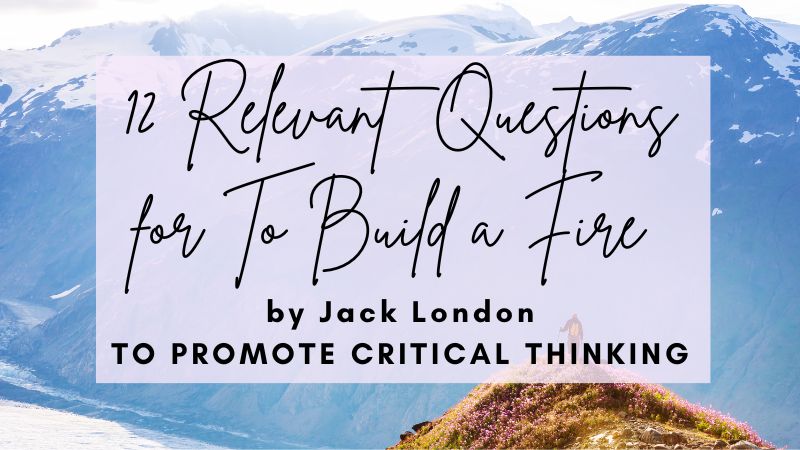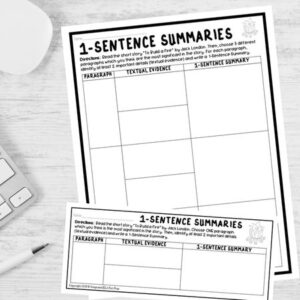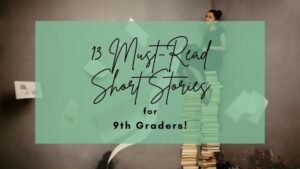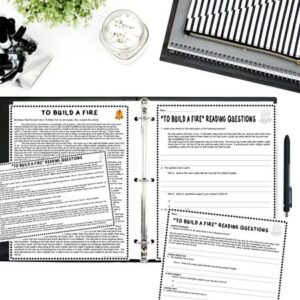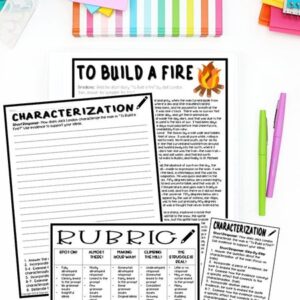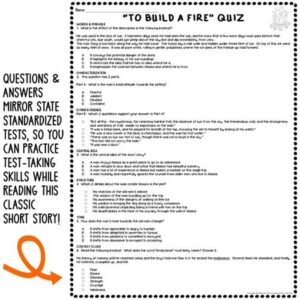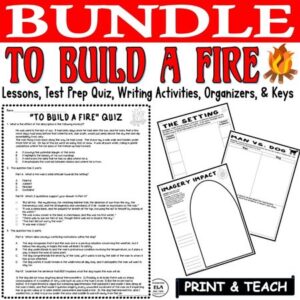I LOVE survival shows! Sometimes these shows use professionals and skilled experts while others just throw someone on an island to see what happens 🙂 Not going to lie…these shows are hilarious. Now, I like to think if I were left alone in the woods to survive on my own, I would totally kill it! And then, there is the truth. Most likely, I would end up crying myself to sleep huddled near a nonexistent fire, eaten alive by a single lone wolf, or bitten by what I think is the most poisonous snake in the world only to find out it was a stick. Because of my addiction, one of my favorite texts to teach is the To Build a Fire story by Jack London!
It’s not too long, the reading level is challenging but not too high, and the plot is easy to follow. Plus, the To Build a Fire story has the benefit of being super realistic.
If you want to make teaching the To Build a Fire story a bit easier, keep reading for 12 Critical Thinking Questions focused on the standards!
Need help with Test Prep? Check out this FREE Pack of 3 Test Prep Activities to help students achieve success on standardized tests!

12 To Build a Fire Story Critical Thinking Questions
Before teaching the To Build a Fire story by Jack London, definitely start with a pre-reading activity.
You could show a clip relating to a survival show, read an article about Jack London, analyze another text by Jack London like this excerpt from White Fang, or play a critical thinking game requiring students to research items they would take to survive in various remote places around the world!
Central Idea Questions for the To Build a Fire Story
1. What is the central idea/main idea of ONE paragraph from the story?
Before you ask for the overall central idea of the entire short story, you may want to encourage students to focus on a single paragraph or chunk. This process helps especially with students who need differentiation!
Here is the first paragraph from the To Build a Fire story:
1 Day had broken cold and grey, exceedingly cold and grey, when the man turned aside from the main Yukon trail and climbed the high earth-bank, where a dim and little-travelled trail led eastward through the fat spruce timberland. It was a steep bank, and he paused for breath at the top, excusing the act to himself by looking at his watch. It was nine o’clock. There was no sun nor hint of sun, though there was not a cloud in the sky. It was a clear day, and yet there seemed an intangible pall over the face of things, a subtle gloom that made the day dark, and that was due to the absence of sun. This fact did not worry the man. He was used to the lack of sun. It had been days since he had seen the sun, and he knew that a few more days must pass before that cheerful orb, due south, would just peep above the sky-line and dip immediately from view.
Central Idea Statement for the first paragraph of the To Build a Fire story: A man is traveling in the Yukon territory, and the surroundings are dark and cold.
2. What textual evidence supports the central idea of the story?
As students read along through a teacher read-aloud, online recording, or independently, I always encourage them to annotate the text for a purpose. If you ultimately want students to write about tone, have them underline for specific diction that evokes the tone. If you want them to identify the main idea, let them choose a sentence from each paragraph that best sums up the main or central idea.
Later on, they can use the best evidence in a written response focused on Jack London’s To Build a Fire story!
Structure Questions for the To Build a Fire Story
3. What are the 5 most important events in this short story?
By assigning students 3, 5, 7, or even 10 events, we give them something to hone in on as they read. When students write, they remember, so as you start, perhaps you could help them with identifying the first event; be sure they are writing down your modeled example.
Additionally, you could discuss why this first event is important by referring to evidence in the text!
4. How does the order of events contribute to the meaning of the story?
Authors are usually intentional in how they begin and end a text. While identifying the type of structure (chronological, cause/effect, compare/contrast, description, etc.) CAN be helpful, our ultimate goal as educators is to get students to analyze the purpose of the structure and its effectiveness.
To answer the question above, you might want students to look at how the story starts and ends. Why begin with a certain description? Why end with a certain description? How does the structure play a role in developing the meaning of the story?
Check out this MUST-READ list of short stories for 9th graders!
Tone Questions for the To Build a Fire Story
5. What is the tone of this excerpt from the story?
But rub as he would, the instant he stopped his cheek-bones went numb, and the following instant the end of his nose went numb. He was sure to frost his cheeks; he knew that, and experienced a pang of regret that he had not devised a nose-strap of the sort Bud wore in cold snaps. Such a strap passed across the cheeks, as well, and saved them. But it didn’t matter much, after all. What were frosted cheeks? A bit painful, that was all; they were never serious.
Ex. Flippant, conceited, uncaring
When teaching tone, ensure that you differentiate between tone and mood.
TONE: attitude (emotion) of the author/speaker
MOOD: the intended emotional impact on the audience; it is created by the setting, scene, actions, etc.
Discovering appropriate tone words is the most difficult part for students, so providing a list might help!
6. How does the man’s tone towards the old men change?
This question is a bit higher level because it asks HOW versus simply WHAT. If you want to up the ante, be sure to ask for textual evidence!
You might also want to ask WHY…asking questions that have multiple parts requires MUCH MORE of our students. And they need to see this process enacted daily in order to progress in their reading abilities.
See more question options in the reading comprehension pack below focused on the To Build a Fire story!
Words & Phrases Questions for the To Build a Fire Story
7. What is the effect of the word “safe” from the following excerpt on the meaning of the work as a whole?
“But he was safe. Toes and nose and cheeks would be only touched by the frost, for the fire was beginning to burn with strength. He was feeding it with twigs the size of his finger. In another minute he would be able to feed it with branches the size of his wrist, and then he could remove his wet foot-gear, and, while it dried, he could keep his naked feet warm by the fire, rubbing them at first, of course, with snow. The fire was a success. He was safe.“
Diction (word choice) is important. When we choose to focus on specific words in a reading passage like the To Build a Fire story, we can get our students to think more deeply. You could even ask students to replace certain words with other words and discuss the varied effects!
8. Read the following excerpt. What does the word “endurance” most likely mean?
“His theory of running until he reached camp and the boys had one flaw in it: he lacked the endurance. Several times he stumbled, and finally he tottered, crumpled up, and fell.”
Students might focus on the following as they learn or review vocabulary during their reading of the To Build a Fire story:
- Use context clues by checking out the diction throughout the sentence.
- Identify synonyms or antonyms; try locating several of each.
- Look up the definition with examples.
- Create a visual for the word and/or excerpt.

Characterization Questions for the To Build a Fire Story
9. Which sentence BEST explains what the dog hopes the man will do?
Animals are valid characters to examine when reading short stories. I would even argue that objects sometimes have a place in character analysis. When it comes to reading texts about survival or stories by Jack London, the animals and the setting most often have relevant character traits!
In fact, focusing on the dog throughout the reading of the To Build a Fire story or even rewriting the story from the dog’s point of view might be a fun activity!
10. What are 2 characteristics of the man?
You could start a lesson on characterization by teaching about various types of character traits! See HERE for a character traits freebie to make introducing this topic simple and easy!
As you read along, make sure to have your students annotate for characterization. What physical, emotional, and mental traits define the protagonist?
By the end of the story, students can create a changing image of the man from start to finish; require evidence for everything though!
Theme Questions for the To Build a Fire Story
11. What is a theme based on the story?
A theme is simply the message of a text. What message, moral, or lesson is the author trying to relay to the audience?
Typically, there is not a perfectly worded theme offered by a story like the To Build a Fire story by Jack London. So as long as students write their thematic statements in a complete sentence and those statements can be supported by relevant textual evidence, I am usually open to offering full credit.
Here is a simple process for helping students write about the theme:
- Identify important topics within a text.
- Think about what the author is trying to say about that topic.
- Put the topic/author message into a complete sentence.
Ex. One should listen to more experienced people before attempting something dangerous.
12. What sentence BEST portrays the theme of the story?
I enjoy it when students read and reread! My favorite teacher quote is “Go back to the text!”
If students don’t go back, they cannot be sure their answers are correct or incorrect. There are bad answers, okay answers, good answers, and great answers!
It is totally okay to differentiate and model each, so students completely understand the differences between them all.
Want to save time with a standards-based To Build a Fire story test prep quiz, click here >>> To Build a Fire Quiz Pack!
TO BUILD A FIRE STORY EXTENSION QUESTIONS
If you need questions to help students think more deeply beyond the text, check out the options below! Most are open-ended, so you can challenge your students at ANY level!
- Would you have done anything differently from the man? How?
- What could the man have done differently?
- What do you think about the dog’s reaction to the man’s death?
- If you were left alone in a similar environment, what would you bring?
- How was the older man valuable?
- Do you listen to people with more experience? Why or why not?
- How might this situation still occur today?
- How might have the story ended differently?
- What one change might have caused a different outcome?
- What research would you do to prepare for a journey in this setting?
TO BUILD A FIRE STORY RESOURCE:
This Jack London’s To Build a Fire Story Lesson Bundle uses the Common Core standards and contains QUESTIONS and ANSWERS modeled after various standardized tests as well as ENGAGING and RIGOROUS reading and writing activities! Make analyzing this classic short story STRESS-FREE!
One of the things I struggle with the most is preparing my students for all kinds of exams that they will encounter. With this EASY-TO-USE bundle, you can practice with your students, so they will feel more confident analyzing short stories and preparing for state assessments. It is great for pull-outs, push-ins, whole groups, small groups, or sub-plans.
Give yourself a breath of fresh air with this NO PREP curriculum that integrates test prep within the teaching of literature! Just PRINT and TEACH!
Need more fun lessons and activities that help you teach the To Build a Fire Story by Jack London? Check out my store Kristin Menke-Integrated ELA Test Prep!

